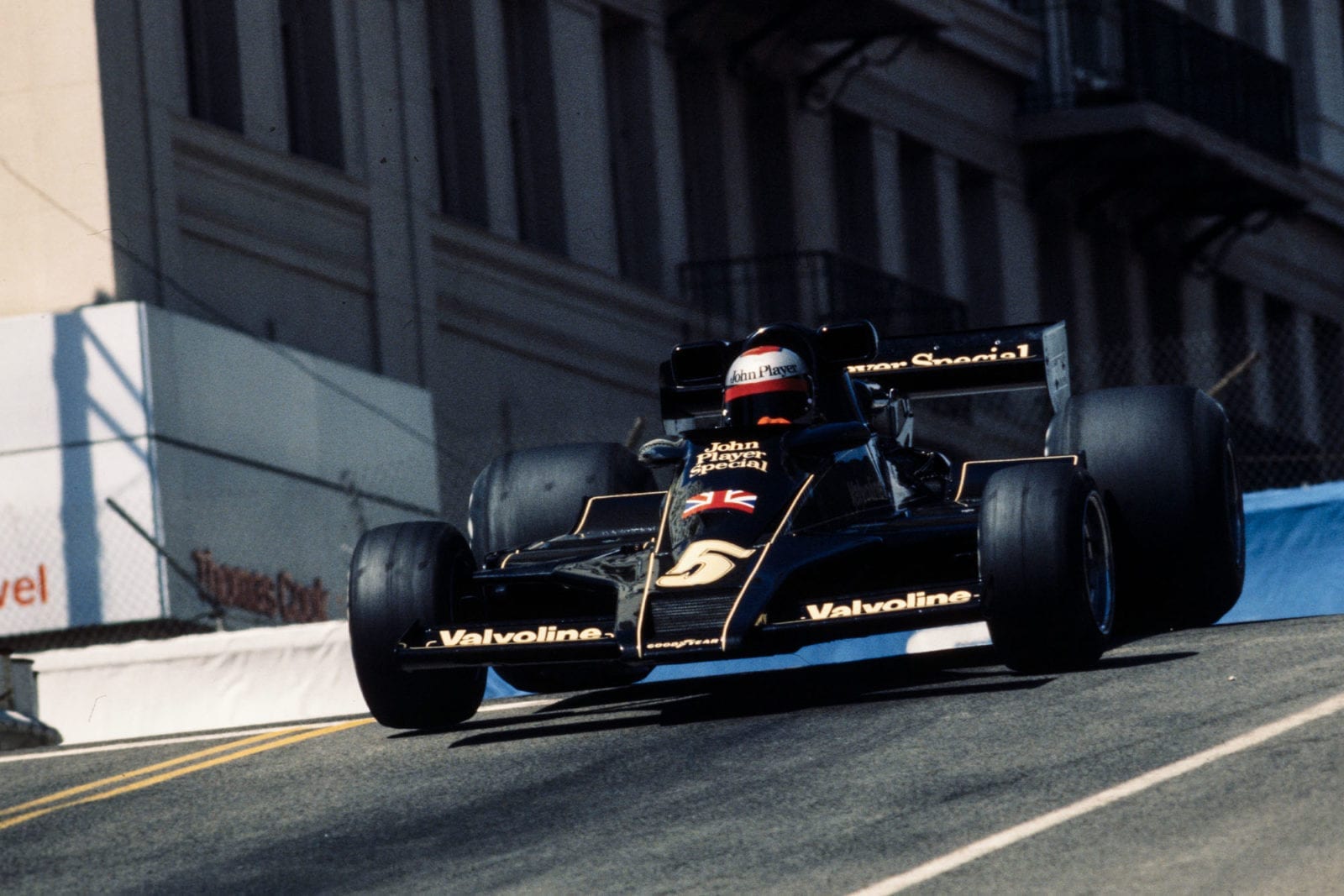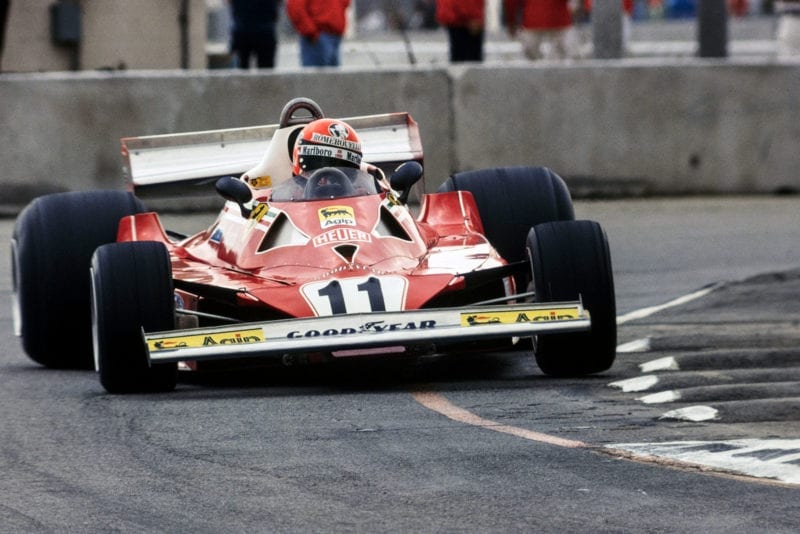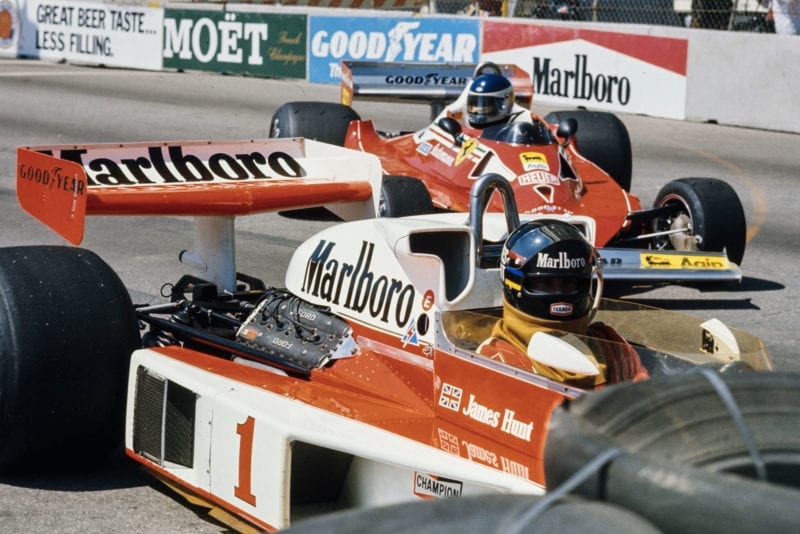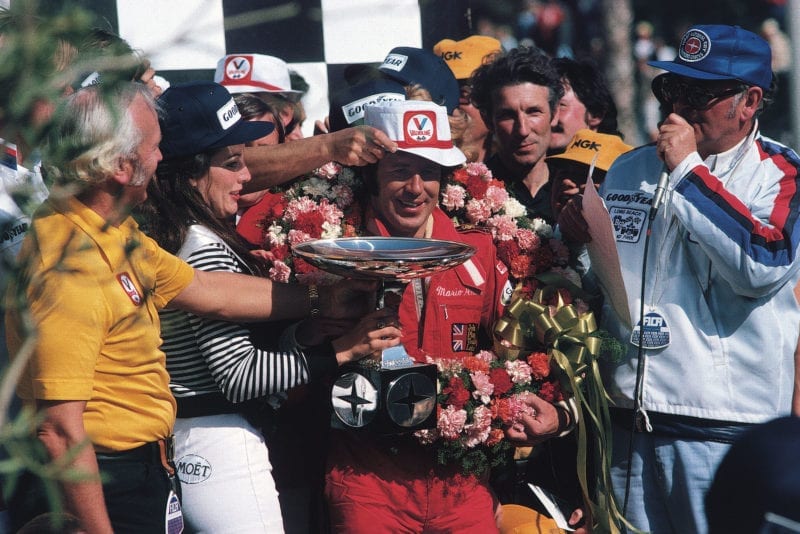1977 United States Grand Prix West race report

Mario Andretti claimed his first win of the season at Long Beach
Motorsport Images
The Racer’s Racer Wins at Home
Long Beach, California, April 3rd
Despite financial and organisational difficulties, the Californian city of Long Beach once again held its street race at the start of April, although the surroundings are hardly as glamorous as they are in Monaco. The United States Grand Prix West is the name of this Formula One event, the fourth round of the 1977 World Championship, as distinguished from the Watkins Glen race which goes under the title of United States Grand Prix pure and simple. Even though the surroundings in Long Beach are a little bit makeshift and dingy, the Long Beach Grand Prix Association has shown a commendable degree of enterprise in staging this race and tackle the whole job with irrepressible enthusiasm and verve. Incidentally, two former American Formula One drivers of considerable repute, Phil Hill and Dan Gurney, are well to the fore on the organisational side in Long Beach and were to be seen taking an active part in proceedings over the weekend.
There had been several driver changes on the Formula One front since the South African Grand Prix at Kyalami. The Shadow team had drawn its breath again after the body-blow inflicted by Tom Pryce’s death and they had signed up Australian Alan Jones to run alongside Zorzi for the rest of the season. Last year Jones was a member of the works Surtees team, but left at the end of 1976 to concentrate on a diverse programme of sports-car and single-seater events in different categories under the patronage of wealthy Hong Kong enthusiast Teddy Yip. When the Shadow offer came up, Yip very kindly released Jones from his obligations to allow him to return to Formula One full-time. To replace Pryce’s DN8/2A, which was totally destroyed in the Kyalami accident, the Northampton based team had built up a brand new chassis (DN8/3A) for Jones to drive while Zorzi continued to rely It the original DN8/1A.
In a similar state of reorganisation was Bernie Ecclestone’s Brabham team for they too had lost their number one driver Carlos Pace since the last Grand Prix, although the Brazilian died in a flying accident in his native Brazil. John Watson was extremely conscious of the responsibility that now rested on his shoulders for although everybody knows that he’s well capable of winning Grand Prix races, Pace had lived with the Alfa-Romeo-engined BT45 car ever since it raced for the first time last year and the popular Brazilian had accumulated a great deal of experience with it. Weighing in as number two in the Brabham team was former March driver Hans Stuck, the German driver changing his mind at the very last minute and deciding not to drive for the ATS team for whom he had tested their ex-works Penske PC4/02 on several occasions.
This change of plan on Stuck’s part left the ATS team absolutely livid, not to mention temporarily without a driver. ATS supply wheels for a large portion of the car market in Germany and were very anxious to have a German driver in their Penske throughout 1977. Nevertheless, they then cast around and came up with a deal for former Shadow driver Jean-Pierre Jarier, an unquestionably fast but frequently rather fickle young man, who hasn’t driven a racing car since last year’s Japanese Grand Prix. In the event Jarier was destined to acquit himself quite respectably.
Qualifying
Official practice took place on the Friday and Saturday prior to the race, there being no opportunity for testing for practice as is so often the case with permanent circuits. However the Wolf team took the opportunity to take their newest chassis WR3 up to the Riverside track for spot of testing and the Shadow team gave Alan Jones a preliminary run there as well, as much to check the new DN8 which had only just been completed as anything else.
Other teams with new cars at Long Beach included the McLaren organisation which had built up yet another new chassis (M23/12) for Jochen Mass to drive; Team Lotus who bought along a third new 1977 machine (78/3) for Mario Andretti to handle, which in turn meant that Gunnar Nilsson took over 78/2 and left his longer 78/1 as a team spare and the Tyrrell team which had an all-new P34/6 for use as the team spare. All three Brabham BT45s were now to specification with their engine mounted lower in the chassis, revised rear suspension and Brabham/Alfa gearbox casings as seen on BT45B/1 tor the first time at Kyalami. In addition to the driver changes mentioned, Brian Henton was recruited into the works March team to drive alongside Alex Ribiero for this race, lan Scheckter still getting over the leg injuries he sustained in a South African Formula Atlantic accident.
With all the problems involved in closing off the streets on the morning of first practice, it was understandable that things fell badly behind schedule on Thursday and the first hour-and-a-half-long timed session was about three hours late when it got under way. Naturally the street surfaces were rather dusty and for the first few laps the cars threw up a haze of debris behind them. This soon cleared and it was Jody Scheckter who set the pace in company with Andretti, the South African driving with great verve within the daunting confines of the concrete barriers that line the Long Beach track. To set a really quick lap time round this circuit demands tremendous control and concentration; not only have you got to drive quickly, you must also be very tidy indeed. Scheckter, using his original Wolf WR1, was both of those things, and ended up fastest with a very convincing 1 min. 22.75, sec. best, two-tenths of a second faster than Andretti who had been experimenting with various front tyre constructions on his brand new Lotus. There was also a tiny rear wing waiting for one of the Lotus drivers to try, but neither took the opportunity to do so, perhaps feeling it had arrived one race too late and Long Beach wasn’t the place to use it!
Jacques Laffite, using the older of his two Ligier-Matra JS7s after chassis 02 had been involved in the Kyalami collision with Pryce’s out-of-control Shadow, got to grips with the twists and turns of Long Beach very well to record the third fastest time, 1 min. 22.993 sec. Laffite was getting the French blue V12 at some incredible angles over the brows and bumps and the shriek from the Matra engine reverberated off the nearby buildings so much that the ground almost shook! The little French team were beside themselves with delight, particularly in view of the fact they were running a 1973 specification engine after all the problems and disappointments of the last few races.
In the Ferrari camp it was Reutemann’s turn to set the pace, the swarthy Argentinian taking his 312/229 round in 1 min. 23.041sec. while team-mate Lauda could only manage 1 min. 23.826 sec. owing to a broken rear anti-roll bar on 30/230. The McLaren camp wasn’t looking its normal confident self at Long Beach for World Champion Hunt couldn’t improve on 1 min. 23.825 sec. during the first session and Mass was way off the pace, both drivers feeling that the M23 had finally come to the end of its useful life. Hunt simply resigned himself to a hard struggle and looked forward to getting back to Britain where he was scheduled to get down to some really intensive testing on the new M26 in time for the Spanish Grand Prix. He consoled himself with the fact that his margin over Mass was about usual, but it was extremely unusual to see the British driver starting a Grand Prix from the fourth row of the grid which is where his eventual best of 1 min. 22,529 sec. placed him. Mass spent the second day aware of slightly more understeer than was to his taste; he soon discovered what the funny feeling at the front of his M23, was about when a suspension ball joint broke and he was left to spectate for the last half hour or so of the last session.
The main issue for front-row grid positions was fought out between Jody Scheckter, Andretti and Lauda on Saturday. Andretti topped the timesheets in the second session on Friday with 1 min. 22.067 sec., Scheckter being foiled when fourth gear broke on his Wolf, but it looked as though the South African would be the man to snatch pole position during the final timed hour of frenzied lapping. However, Niki Lauda thought otherwise and, in one supreme final fling, slashed his best to 1 min. 21.630 sec. pulling into the pits with ten minutes still to go and simply watching everybody close trying to catch him. It was an extremely confident performance by Lauda and he proved to be quite correct nobody did catch him. Andretti put everything he’d got into a last spurt to record second fastest time with 1 min. 21.868 sec., pushing Scheckter back onto the second row with 1 min. 21.887 sec. Reutemann had no intention of being left behind by his team-mate and responded with a 1 min. 22.260 sec., but this wasn’t in the sub- 1 min. 22 sec. “ace” category although it was “best of the rest”.

Niki Lauda set the fastest time to take pole
Motorsport Images
Laffite dropped back to fifth place in that last-minute scramble (1 min. 22.296 sec.) sharing the third row of the grid with an irate Watson who’d had nothing but trouble during the final hour. Firstly the selector plunger on first and second gear had broken in the BT45B’s gearbox and then the alternator belt broke. Once these problems had been seen to the Ulsterman had a bad time getting past slower cars on the circuit, notably Brian Henton’s March, and the usually quiet Watson was extremely terse with the Derby driver once the session was over. In his extreme irritation, Watson also spun his Brabham on the tight right-hander before the pits ironically almost collecting the blue works March as a result.
The fourth row of the grid saw quite an upset from usual form with Jarnes Hunt’s McLaren eighth fastest, beaten by Emerson Fittipaldi who was absolutely delighted with his Copersucar-backed FD04/3, possibly for the first time since he started driving it at the beginning of 1976. Minor suspension geometry changes now meant that the car felt smooth and progressive and it was obvious to everybody that E.F. felt much more confident than usual. His fastest was 1 min. 22.382 sec., seven-tenths of a second off the pole position time.
The inside of the fifth row provided quite a surprise as well, for inside Ronnie Peterson’s Tyrrell P34 sat Jarier in the ATS Penske. Towards the end of last year Jarier’s leisurely gait at the wheel of the second works Shadow led one to believe that the Frenchman had either given up driving a Formula One car or forgotten how to do it properly. The result was that he was dropped from the Shadow team and even excluded from the Le Mans Renault-Alpine team; something that surprised him a bit, to say the least. Over the winter he has had a long “think” about his approach to professional racing and it was very clear at Long Beach that he was grateful for getting a “second chance”. He expressed himself delighted with the Penske and, after getting the cockpit altered to suit him (it had been originally set up for the lanky Hans Stuck) turned in a very reasonable 1 min. 22.611 sec.
As far as the two Tyrrell drivers were concerned, Long Beach was something of a disaster. Both Peterson and Depailler were well off the pace with their six-wheelers and no amount of fiddling with roll bars and spring rates seemed to make their lives appreciably easier. They jinked and hopped over the bumps and Depailler’s efforts during the first session ended with him clumping the right rear corner against the wall and breaking an upright. He immediately transferred to the team’s brand new spare P34/6, but this had a cockpit set up for the much taller Peterson, as the Frenchman swapped back to his original car which had been repaired in time for the second session. Peterson’s best was 1 min. 22.655 sec. while Depailler clocked 1 min. 22.675 sec., the two French blue machines separated by Vittorio Brambilla’s Surtees TS 19/06, the Italian driver finding a six-speed gearbox a little more difficult than it was worth round the tight street circuit.
Problems afflicted Clay Regazzoni in the familiar Ensign MN06, mainly connected with a continuing and bewildering shortage of sheer straight line speed. His best of 1 min. 22.762 sec. was three-tenths of a second better than Jones could manage in the Shadow DN8 even though the Australian’s car underwent an engine change after the Friday sessions. Mass’ lowly position was attributable, as mentioned, to his missing out much of the final session while brake balance problems prevented Nilsson from acclimatising himself to the short-wheelbase Lotus 78 and he’d got other problems including a broken shock-absorber to occupy his mind. In the final session the Swede got a bit too keen in trying to make up for lost time and clipped one of the concrete barriers which broke one of the Lotus’ top links and sidelined Nilsson for the remainder of the session.
On his first outing for the Brabham team Stuck didn’t look terribly impressive, but a combination of brake problems and oil leaks as he switched around between his designated race car and the training car meant that he barely got a decent lap together during the final session. Henton reckoned that the understeer on his works March was simply diabolical, while the last two rows of the grid were populated by Binder, Zorzi, Lunger and Ribiero for a variety of diverse reasons all of which simply added up to the fact that they didn’t go fast enough at the right time.
Race

James Hunt (McLaren) finds himself buried in the barriers
Motorsport Images
Sunday’s race promised to be a really first class contest although there were those who recalled the opening stages of the first Formula One race to be held at Long Beach with a degree of apprehension. The short sprint down from the startline leads into a very tight and tricky right-hand corner which immediately drops away downhill and then into another tight no-degree left-hander. Last year it was Reutemann (Brabham BT45) and Brambilla (March 760) who failed to make it round the first corner; who would it be this year?
Quite clearly, Jody Scheckter reasoned, the way to make sure you’re not involved in a first corner accident is to be the first man round that corner. When the starter’s signal was given the black and gold Wolf was away, rocketing up the inside of Lauda’s Ferrari with its right rear wheel almost grazing the pit wall as he did so. But to the amazement of everybody watching at that first corner, Reutemann tried to follow the South African through and left his braking impossibly late as he attempted to slip in behind Scheckter.
Lauda immediately lifted off when he saw what was going to happen, as did Andretti. Reutemann’s Ferrari, its front wheels locked hard on, slid up the inside of his team-mate and straight across the corner, down the escape route. Lauda and Andretti nipped round behind the Argentinian’s car and, as Laffite followed them round to take fourth place, chaos erupted as Hunt’s McLaren suddenly became airborne over the right front wheel of John Watson’s Brabham BT45B. The World Champion’s car crashed back onto the ground and shuddered to a halt alongside Reutemann in the escape road while Peterson also joined them as he hadn’t got much in the way of option, being where he was on the left-hand side of the grid. Watson just got round, but instantly another “gerfuffie” was breaking out as Brambilla got the left front wheel of his Surtees hooked inside the right rear wheel of Mass’ McLaren. The Surtees reared up into the air, fracturing its water radiators and showering hot coolant everywhere, before slamming to a standstill as Mass went on his way. A foolish track official subsequently tried to move the damaged Surtees only to have it run away across the track and hit the guard rail halfway down the hill. Both Reutemann and Hunt resumed the race at the back of the field, the Argentinian only lasting until mid-way round the fifth lap when he collided with Lunger’s March, which he was trying to pass, and promptly trailed round to retire with suspension damage. Lunger was obliged to abandon his car out on the circuit with a broken upright.
Andretti slipped past Lauda before the field completed the opening lap, but it was Scheckter’s Wolf that burst into view past the pits in the lead with the Lotus and Ferrari hard in pursuit. They had already opened a slight lead over Laffite’s blaring Ligier, Watson, Fittipaldi, Jarier, Jones, Depailler, Nilsson, Regazzoni, Binder, Heston, Stuck, Zorzi, Lunges, Ribiero and Peterson. Right at the back were the two works McLarens after their first corner mix-ups plus Reutemann in the Ferrari.
By lap three Watson had found a way round Laffite’s Ligier, the Brabham-Alfa pulling away slightly from the French car despite the impact with Hunt’s McLaren having sparked off what was to result in a slow puncture and, in the meantime, an aggravating degree of understeer. For a couple more laps it seemed as though Watson might actually make some ground on the leaders, but their advantage soon stabilised and then gradually grew.
This was motor racing with no let-up. Scheckter was driving extremely confidently, hurling his Wolf round with a dash of opposite lock that let his two immediate pursuers know full-well that he wasn’t to be trifled with on this particular day. Andretti watched, cool and confident, from a few yards behind, while Lauda simply hung on grimly, having flat-spotted one of his Ferrari’s front tyres under harsh braking in the opening stages of the race. Watson held onto his fourth place until lap 15 when he finally conceded to Laffite and pulled into the pits in order that the deflated front tyre be changed. He resumed back in 15th place and began pulling back through the field until his gearbox refused to engage first and second gears. Then he dropped away again, finally retiring from the race after he had stopped in front of the pits with a dead engine and mechanics who went to coax the car back into life were rightly deemed to be outside assistance, so Watson was blackflagged.

Scheckter took an early lead but eventually finished 3rd
Motorsport Images
Aside from the high-speed deadlock that seemed to have set in at the front of the field, where none of the leading trio was gaining or giving anything significant, there was plenty of activity further down the overall order. Behind the plucky Laffite, Depailler was hanging onto fifth place with his twitchy Tyrrell, anxious not to let Fittipaldi get too close with his Copersucar, while the Brazilian had Jones close behind in the Shadow and then a good scrap between Nilsson and Jarier. Peterson was forced into the pits to change a flat-spotted front tyre on his Tyrrell P34, and while his subsequent progress was certainly spectacular to watch it didn’t exactly get him anywhere. He got back as far as 12th place behind Stuck where he stayed until a disconnected fuel line stopped him out on the circuit near the end of the race.
At around the half-distance point Scheckter got a couple of lucky breaks whilst lapping slower cars but Andretti and Lauda were not giving up under any circumstances and within a couple of laps they were back on the Wolf’s tail again. Jones retired his Shadow from sixth place on lap 4, the gearbox having broken in just the same fashion as his team-mate Renzo Zorzi’s some 13 laps earlier. In addition, Mass stopped his McLaren after he had completed 39 laps in order to investigate a disturbing vibration from somewhere in the transmission. It was by no means clear whether the problem had been bought about by Mass first corner collision with Brambilla, but the decision was taken to retire the car all the same.
While all this was going on, Stuck was having a terrible time in the second Brabham BT45B, several trips up the escape road at the end of the start/finish straight testifying to the problem he was still having with the brakes on BT45B/1. With 53 laps completed he finally called it a day and retired from the race, the problems apparently too difficult to solve in the pits.
As the laps went by it was increasingly clear that only a mechanical failure or an unexpected driving lapse would rob Scheckter of victory; and the latter wasn’t very likely because he had dealt with both Andretti and Lauda from the word go and showed every indication of maintaining the pace. But with slightly less than 20 laps still to go, Scheckter alone was becoming increasingly aware of a major problem. Slowly at first, but quite perceptibly he felt the Wolf getting less and less stable under very heavy braking. To his disbelief, he realised that the right front tyre was slowly deflating. Gradually the problem got worse, but he simply gritted his teeth and pressed on as hard as ever, hoping that the offending rubber would survive the 80 laps out.
Sadly, there was no way it would. To the accompaniment of shrieks from the enormously partisan crowd, Andretti pressed harder and harder before finally slipping inside the Wolf at the end of the long back straight mid-way round his 77th lap. Scheckter tried everything he knew to fend him off, but there was no denying the determined American driver. At that point Scheckter’s resistance collapsed as the Wolf’s front tyre deflated even more; there was no fending off Lauda and the Ferrari quickly went through to challenge Andretti for the lead. But with the crowd willing him on Andretti wasn’t about to let a Ferrari stand between him and victory as the first American ever to win a World Championship qualifying race on his home soil. Although Binder and Henton held up the leading Lotus on the last lap, Andretti remained well in control of the situation to come home a confident and popular winner by less than a second from the hard-trying Lauda. Scheckter crept home a dejected and disappointed third while Depailler received an added bonus with four laps to go, inheriting fourth place after a complete electrical failure stopped the Ligier Matra out on the circuit. Fittipaldi finished a satisfied fifth ahead of an equally happy Jarier who’d proved that perhaps the Shadow DN5 wasn’t all that it was cracked up to be last year after all. James Hunt drove unobtrusively and steadily after that first lap incident, coping well with bent front suspension, to finish seventh in his McLaren while Nilsson was handicapped by a slow puncture in the closing stages of the race. Henton finished 10th, worn out by wrestling with his March’s seized steering rack, while Binder was the last classified finisher after a pit stop in his Surtees.

Andretti celebrates on the podium
Motorsport Images
It had been a tremendous race and a worthy victory for Andretti and the Lotus team. He might not have dominated the race like Scheckter did, but he hammered home his attack all through the race in the hope that a chink would appear in the Wolfs armour. It did, so he won the race. – A.H.
